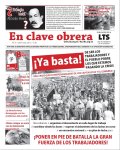Economy
No let up in the financial crisis
27/08/2007 Originally published on August, 17th 2007
Losses in the periphery, severe loss on the Japanese stock exchange,
and lower discounted interest rates in the US
The news this week is that the semi-colonial countries have been
violently added to the international financial crisis, as Japanese
investors and many hedge funds (funds to cover risks) are getting rid
of, or find themselves forced to get rid of, speculative positions and
investments of assets in the periphery, especially in Asia. In recent
years, it was usual to take out loans at nonexistent rates in Yen
(Japanese currency), in order to invest them afterwards in risky
assets ("carry trade"). This is what explains, among other things, the
severe fall in the emerging markets of Asia this week.
BNP Paribas* calculates the financial assets accumulated by this
practice as a trifle of 1.2 billion dollars that flooded the markets
and assets of the Asian periphery or in places as remote as Iceland,
New Zealand or Brazil. The rising tide of Yen has been one of the main
sources that inundated the assets markets in the last two years,
together with the surplus of petrodollars from oil-exporting countries
as well as the big foreign currency reserves of countries like China
or Russia. The sale of these assets to repay loans taken out in Japan
is what explains the strong rise of the Yen. The scale of the upward
movement recalls the violent rise of the Yen in 1998, a central factor
in the chain reactions that led to the global banking crisis of a
decade ago. These memories and the gloomy outlook that hovers over the
world economy, have now sunk the Tokyo stock exchange, that fell 5.4%,
its biggest loss since the attacks of September 11, 2001. These losses
savagely battered the stocks of the Japanese machinery manufacturers
like Komatsu, that had increased their sales in China and to raw
material producing countries.
Later, in a surprise move, the Federal Reserve reduced its discount
rate (the rate at which it makes loans to the banks), which proves the
seriousness of the financial crisis and shows a willingness to reduce
federal interest rates, as speculators and big financial raiders from
Wall Street have been desperately demanding. As we stated in earlier
articles, the crisis has its epicenter and threatens to strike
fiercely at the heart of world finance. In Europe: the main European
banks have already lost more than 10% of their stock value. And this
is only the beginning!
Eastern Europe, the weakest link in the international financial crisis
A minor movement of "carry trade," similar to that of the Yen, but
with Swiss Francs has flooded Eastern Europe in recent years,
financing a regional real estate bubble. More than 80% of all the
mortgages in Hungary in the last year have been in Swiss Francs. The
current account deficit is 25% of the GDP in Latvia and Bulgaria, and
18% in Rumania. Hungary has a fiscal deficit as well as a deficit in
current accounts. These deficits are rapidly increasing. Eastern
Europe resembles Asia before the crisis of 1997 and could be the first
link in the capitalist chain to break.
Translation by Yosef M.
=====
[*BNP Paribas is one of the main banks in Europe. "On August 9, 2007
BNP Paribas announced that it could not fairly value the underlying
assets in three funds as a result of exposure to U.S. subprime
mortgage lending markets. Faced with potentially massive (though
unquantifiable) exposure, the European Central Bank (ECB) immediately
stepped in to ease market worries by opening lines of €96.8 billion
(US$130 billion) in low-interest credit." From wikipedia.org]








